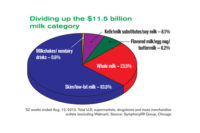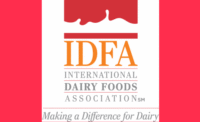
Carving Out A Niche
by James Dudlicek
The dairy industry is booming — if you’re
making the right thing.
Could anyone in recent
history have imagined a time when demand for fluid milk would be outpacing
supply to such an extent that a processor would be compelled to restrict
shipments?
It’s happening.
Did you ever think demand for cheese would ever be so strong that New Mexico would join the ranks of the top dairy states?
It’s happening.
Who could imagine a summer with sagging ice cream sales, while development of better-for-you frozen treats continues to expand?
It’s happening.
Did you ever expect American consumers to finally catch on to the benefits of probiotics in cultured dairy products?
It’s — well … it’s starting to happen.
Did you ever think demand for cheese would ever be so strong that New Mexico would join the ranks of the top dairy states?
It’s happening.
Who could imagine a summer with sagging ice cream sales, while development of better-for-you frozen treats continues to expand?
It’s happening.
Did you ever expect American consumers to finally catch on to the benefits of probiotics in cultured dairy products?
It’s — well … it’s starting to happen.
Yes, it’s all true, friends. Demand for fluid
milk is rapidly outstripping supply — in the organic sector, leading
Dean Foods to consider rationing organic milk shipments this winter until
it can catch up with demand for its Horizon Organic products. Meanwhile,
the nation’s top dairy processor is spending millions to help family
farmers transition to organic and expand grazing land and milking
operations for its Idaho organic dairy herd.
New Mexico became the country’s seventh-largest
milk producing state in 2004, according to the latest USDA reports; that
state wasn’t even on the list in 1980. Much of that milk is feeding
the new Southwest Cheese mega-plant in Clovis. Just over the state line in
the Texas panhandle, Hilmar is constructing another major facility, while
throughout the west new or expanding plants are helping processors keep up
with Americans’ insatiable appetite for cheese.
Per capita cheese consumption has more than doubled
since 1980, the USDA reports, with Italian and other ethnic cheeses making
strides against traditional American and cheddar styles.
And even as a heat wave grips much of the nation,
overall ice cream sales appear to have slipped, perhaps a casualty of
growing concerns over health, wellness and obesity. On that side of the
coin, processors continue to develop better-for-you alternatives that taste
as good as the real thing.
Gut-health truths understood for decades abroad may
finally have started to make inroads here, with the U.S. launch of
Dannon’s Activia leading the way after years of success in Europe.
This step bodes well for the already booming yogurt segment that’s
blessed with an innate wellness profile.
Overall, per-person consumption of dairy products
climbed by 0.4% per year since 1995, the USDA reports, with most of that
demand growth coming from increased cheese consumption in restaurants or as
part of pre-packaged foods. The agency says this may make dairy demand more
sensitive to general economic conditions than in the past.Despite
strides in school milk, increased attention toward wellness and broad
recognition by household gatekeepers of the dairy-weight loss link,
beverage milk sales are virtually the same as in the mid-1980s. Fluid milk
products represented 36 percent of total milk use in 2004, down from almost
50 percent three decades ago.
“The once clear-cut dramatic substitutions of
lower-fat milks for whole milk have not been seen since the
mid-1990s,” the USDA reports. “Recent data suggests little or
only slow growth in any of the key fluid milk categories.”
Eating out and food processing account for a majority
of dairy product use, according to the USDA. Restaurant demand —
mainly for cheese, butter and cream — has become particularly
important in recent years. Cheese has become the primary end use for raw
milk, with its share more than doubling since 1975 to 52 percent in 2004.
Processed food manufacturers are showing greater interest in using dairy
ingredients — milkfat, skim solids, whey proteins and lactose —
in their products due to their desirable taste, nutritional and functional
attributes.
Globally, the dairy industry is doing well. The
indexed return for dairy companies outpaced the Dow Jones, Nasdaq and
S&P 500 indexes in nearly every period over the past year, according to
data from Chicago-based Houlihan Lokey Howard and Zukin. Among dairy
companies worldwide, France’s Groupe Danone leads the pack with
revenue of more than $17.4 billion; the U.S. leader, Dallas-based Dean
Foods Co., follows at more than $10.5 billion, according to Houlihan
Lokey’s 2006 mid-year report. Rounding out the top five in that
report are France’s Bongrain SA ($5.2 billion), Canada’s Saputo
Inc. ($3.2 billion) and U.K.-based Dairy Crest Group plc ($2.5 billion).
Growing global demand for American dairy products and
the loosening of trade barriers will certainly open new opportunities for
U.S. processors, despite a breakdown in World Trade Organization Doha Round
talks announced shortly before press time.
Meanwhile, the trends are clear at home. Follow our
category-by-category report for ideas on how to succeed in the dairy
business by really trying.
Is it happening for you?
$OMN_arttitle="Carving Out A Niche";?>
